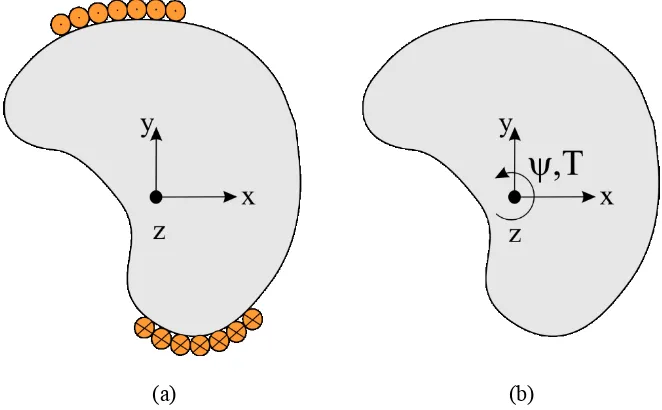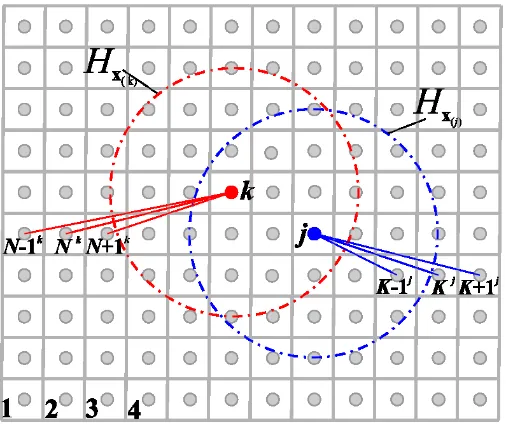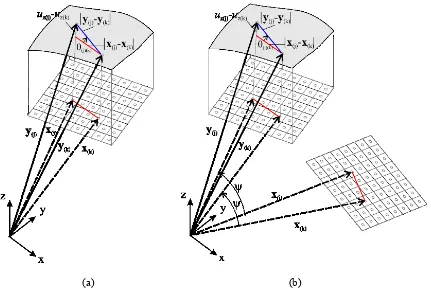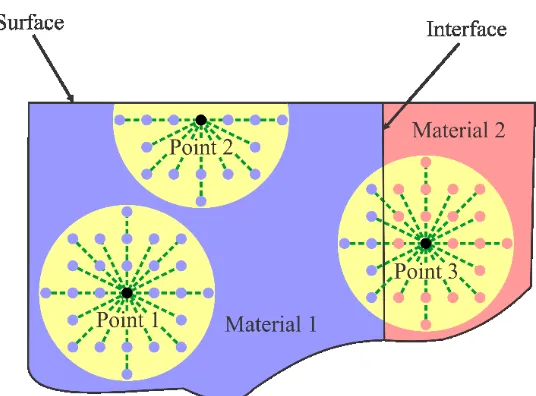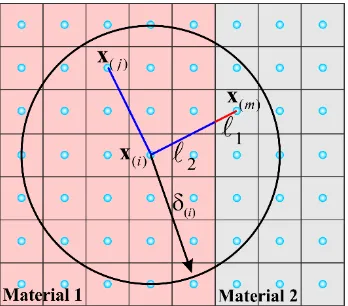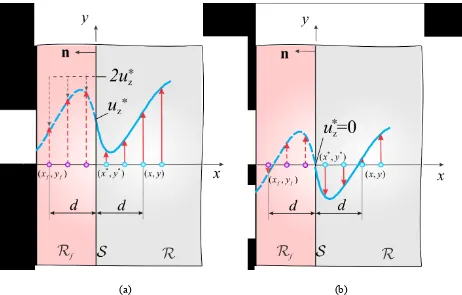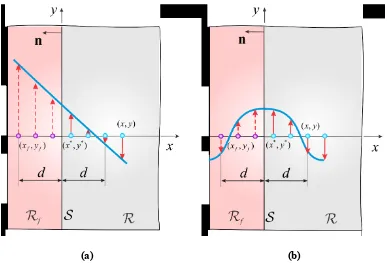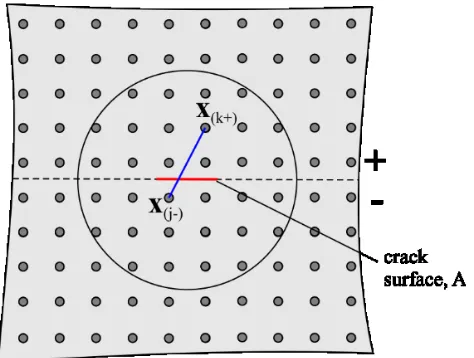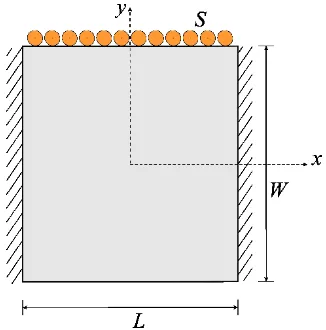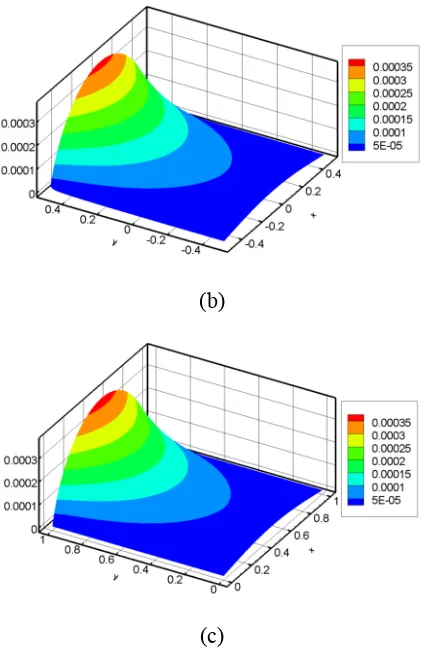1
Peridynamics for anti-plane shear and torsional deformations
Selda Oterkus, Erdogan Madenci*
Department of Aerospace and Mechanical Engineering, The University of Arizona, Tucson, AZ 85721, USA
Abstract
A rod or beam is one of the most widely used members in engineering construction. Such members
must be properly designed to resist the applied loads. When subjected to anti-plane (longitudinal) shear
and torsional loading, homogeneous, isotropic, and elastic materials are governed by the Laplace equation
in two dimensions under the assumptions of classical continuum mechanics, and are considerably easier
to solve than their three-dimensional counterparts. However, when using the finite element method in
conjunction with linear elastic fracture mechanics, crack initiation and its growth still pose computational
challenges, even under such simple loading conditions. This difficulty is mainly due to the mathematical
structure of its governing equations, which are based on the local classical continuum theory. However,
the nonlocal peridynamic theory is free of these challenges because its governing equations do not contain
any spatial derivatives of the displacement components, and thus, are valid everywhere in the material.
This study presents the peridynamic equation of motion for anti-plane shear and torsional deformations,
as well as the peridynamic material parameters. After establishing the validity of this equation, solutions
for specific components that are weakened by deep edge cracks and internal cracks are presented.
Keywords: Peridynamics, nonlocal, anti-plane shear, torsion, fracture
*Corresponding author. Tel.: +1 520 621 6113.
2
1. IntroductionPrediction of structural failure loads due to crack initiation and propagation is still a challenging area
of solid mechanics. Many different techniques are proposed and widely used within the scope of classical
continuum mechanics. The traditional approaches to predict failure usually employ concepts from linear
elastic fracture mechanics (LEFM). The major drawback of LEFM is the requirement of a pre-existing
initial crack in the structure. Hence, it is not capable of predicting crack initiation. Furthermore, the
mathematical formulation results in unphysical (singular) stress values at the crack tips. To overcome
these problems, cohesive zone models (CZM) and extended finite element methods (XFEM) are widely
accepted as an alternative and implemented in the commercially available finite element analysis
programs.
Although relatively new, peridynamics (PD), introduced by Silling [1] by reformulating the classical
continuum mechanics equations, is very suitable for failure analysis of structures because it allows cracks
to grow naturally without resorting to external crack growth laws. PD is based on integro-differential
equations as opposed to the partial differential equations of classical continuum mechanics. An extensive
literature survey on peridynamics is given by Madenci and Oterkus [2]. A comparison study between
peridynamics, CZM, and XFEM techniques by Agwai et al. [3] highlights the capability of the PD theory.
They showed that the crack speeds obtained from all three approaches are of the same order; however, the
fracture paths obtained through the PD theory are much closer to the experimental results than those of
the other two techniques.
The numerical simulation of three-dimensional structures can be computationally costly. Although all
structures are three dimensional in nature, they can be idealized under certain assumptions. Under such
idealization, a rod or a beam subjected to anti-plane (longitudinal) shear and torsional loading can be
analyzed in two dimensions. However, the PD equation of motion and the PD material parameter must
reflect these idealizations. As shown in Figure 1, this study presents the derivation of the PD equation of
3
establishing its validity by comparing against benchmark solutions, a study of components that are
weakened by deep edge cracks and internal cracks is presented.
[image:3.612.140.471.136.341.2](a) (b)
Figure 1. A beam under (a) anti-plane shear and (b) torsion.
2. Kinematics for anti-plane shear and torsional deformation
Due to the nature of loading and the geometry of the components, the deformation of the cross section
on the -z plane is dependent only on the -x and -y coordinates. Also, the cross section of the component remains uniform. At any instant of time, every point in the material denotes the location of a material
particle, and these infinitely many material points (particles) constitute the continuum. In the undeformed
state of the body, each material point is identified by its coordinates, x( )k with (k1,2,..., ) , and is
associated with an incremental volume, V( )k , and a mass density of (x( )k ). Each material point can be subjected to prescribed body loads, displacement, or velocity, resulting in motion and deformation.
According to the PD theory introduced by Silling [1], the motion of a body is analyzed by considering
the interaction of a material point, x( )k , with the other, possibly infinitely many, material points, x( )j,
4
interacting with x( )k is assumed to vanish beyond a local region (horizon), denoted by Hx( )k , shown in Figure 2. Similarly, the material point x( )j interacts with the other material points in its own family,
( )j
Hx
. The range of the material point x( )k is defined by , referred to as the “horizon.” Also, the material points within a distance of x( )k are called the family of x( )k ,
( )k
Hx . The interaction of material points is prescribed through the micropotentials that depend on the deformation and constitutive properties of the
material.
As shown in Figure 2, material point x( )k interacts with its family of material points,
( )k ,
Hx and is
influenced by the collective deformation of all these material points. Similarly, the material point x( )j is
influenced by deformation of the material points,
( )j,
[image:4.612.180.433.365.577.2]Hx in its own family.
5
With respect to a Cartesian coordinate system, the material point ( ) { ( ), ( ), ( )}
T
k xk yk zk
x experiences
displacement, ( ) { ( ), ( ), ( )}
T
k uk vk wk
u , and its location is described by the position vector y( )k x( )k u( )k in
the deformed state, as shown in Figure 3. The body load vector at material point x( )k is represented by
( ) {0,0, ( )}
T
k bz k
b , respectively. The motion of a material point conforms to the Lagrangian description. In
the deformed configuration, the material points x( )k and x( )j experience displacements u( )k and u( )j ,
respectively. Their initial relative position vector (x( )j x( )k ) prior to deformation becomes (y( )j y( )k )
after deformation.
Under anti-plane and torsional loadings, the initial position of material points x( )j and x( )k for
( )j ( )k
z z z can be defined as ( )T { ( ), ( ), } j xj yj z
x and ( )T { ( ), ( ), }
k xk yk z
x . Their initial relative position
can then be expressed as
( ) ( ) ( ) ( ) ( ) ( )
( T T ) {( ),( ),0}
j k x j xk yj yk
x x (1)
For anti-plane shear deformation, these material points experience the displacements:
( ) {0,0, ( )} and ( ) {0,0, ( )}
T T
j uz j k uz k
u u . Their relative position in the deformed state becomes
( )j ( )k ( )j ( )k uz j( )uz k( ) z
y y x x e (2)
For torsional deformation, these material points experience the displacements:
( ) { ( ), ( ), ( )}
T
j zyj zx j uz j
u and ( )T { ( ), ( ), ( )}
k zyk zxk uz k
u , in which represents the angle of twist.
Their relative position can be expressed as
( )j ( )k ( )j ( )k ( ( )j ( )k ) uz j( )uz k( ) z
y y x x x x e (3)
in which T {0,0,z}, and the product term
( ) ( )
( j k )
x x represents the rotation of (x( )j x( )k )
6
As shown in Figure 3, the relative out-of-plane displacement (elevation) of material points x( )j and x( )k
is defined as
( )( )k j z j( ) z k( )
e u u (4)
Also, the slope of this elevation (change in angle) between material points x( )k and x( )j is defined as
( )( ) ( ) ( ) ( )( )
( )( ) ( )( )
k j z j z k
k j
k j k j
e u u
r
(5)
where ( )( )k j |x( )j x( )k | represents the distance between these material points.
[image:6.612.92.523.288.593.2](a) (b)
7
3. Ordinary state-based peridynamicsDue to the interaction between material points x( )k and x( )j , a scalar-valued micropotential, w k j , develops; it depends on the material properties, as well as the elevation, e( )( )k j , between point x( )k and all other material points in its family. Note that w j k w k j because w j k depends on the state of material points within the family of material point x( )j . These micropotentials can be expressed as
( )( )k j ( )( )k j e(1 )( )k k ,e(2 )( )k k ,
w w (6a)
and
( )( )j k ( )( )j k e(1 )( )j j,e(2 )( )j j ,
w w (6b)
in which e( )( )j k uz j( )uz k( ) represents elevation between material points x( )k and x( )j . The change in elevation, e(mk)( )k , is measured between point x( )k and the m-th material point that interacts with point
( )k
x . Similarly, e(mj)( )j is measured between point x( )j and the m-th material point that interacts with point
( )j
x , as shown in Figure 2. The strain energy density, W( )k , of material point x( )k can be expressed as a summation of all the micropotentials, w( )( )k j , arising from the interaction of material point x( )k and the other material points, x( )j , within its horizon in the form
( ) ( )( ) (1 )( ) (2 )( ) ( )( ) (1 )( ) (2 )( ) ( ) 1
1 1
, , , ,
2 2 k k j j
k k j k k j k j j j
j
W e e e e V
w w (7)in which w( )( )k j 0 for k j.
The PD equation of motion at material point x( )k can be derived by applying the principle of virtual
work, i.e.
1 0
( ) 0
t
t T U dt
(8)8
( ) ( )
0
z k z k
d L L
dt u u
(9)
where the Lagrangian L is defined as L T U .
The total kinetic and potential energies in the body can be obtained by summation of kinetic and
potential energies of all material points, respectively,
( ) ( ) ( ) ( ) 1
1
2 i z i z i i
i
T u u V
(10a)and
( ) ( ) ( ) ( ) ( )
1 1
i i z i z i i
i i
U W V b u V
(10b)Substituting for the strain energy density, W( )i , of material point x( )i from Eq. (7), the potential energy can be rewritten as
( )( ) (1 )( ) (2 )( ) ( )( ) (1 )( ) (2 )( ) ( ) ( ) ( ) ( )
1 1
1 1
, , , ,
2 2 i j i i i i j i j j j j j z i z i i
i j
U e e e e V b u V
w w (11)The Lagrangian can be written in an expanded form by showing only the terms associated with the
material point x( )k as
( ) ( ) ( ) ( )
( )( ) (1 )( ) (2 )( ) ( )( ) (1 )( ) (2 )( ) ( ) ( ) 1
( )( ) (1 )( ) (2 )( ) ( )( ) (1 )( ) (2 )( ) ( ) ( ) 1 1 ... 2 1 1 , , , , 2 2 1 1 , , , , 2 2
k k j j
i i k k
k z k z k k
k j k k j k j j j k
j
i k i i k i k k i k
i
L u u V
e e e e V V
e e e e V V
w ww w
( ) ( )
( )... b uz k z k Vk
(12a)
9
( ) ( ) ( ) ( )( )( ) (1 )( ) (2 )( ) ( ) ( ) 1
( )( ) (1 )( ) (2 )( ) ( ) ( ) 1 ( ) ( ) ( ) 1 2 1 , , 2 1 , , 2 . k k j j
k z k z k k
k j k k j k
j
j k j j j k
j
z k z k k
L u u V
e e V V
e e V V
b u V
w w (12b)Substituting from Eq. (12b) into Eq. (9) results in the Euler-Lagrange equation of the material point x( )k
as
( ) ( ) ( )( ) ( ) ( ) ( ) ( )1 1 ( ) ( ) ( )
( ) ( ) ( )( )
( ) ( ) ( )
1 1 ( ) ( ) ( )
1 2
1
0
2
z j z k k j
k z k k i
j i z j z k z k
z k z j j k
i z k k
j i z k z j z k
u u
u V V
u
u u
u u
V b V
u u u
w w (13a) or
( )( ) ( ) ( ) ( )1 1 ( ) ( )
( )( )
( ) ( )
1 1 ( ) ( )
1 2 1 0 2 k j
k z k i
j i z j z k
j k
i z k
j i z k z j
u V u u V b u u
w w (13b)in which it is assumed that the interactions not involving material point x( )k do not have any effect on
material point x( )k . Based on the dimensional analysis of this equation, it is apparent that the quantity
1 ( ) ( )( )/ ( ( ) ( ))
i Vi k i uz j uz k
w represents the force density in the -z direction that material point x( )j
exerts on material point x( )k and i1 ( )Vi ( )( )i k / (uz k( ) uz j( ))
w represents the force density in the -z
direction that material point x( )k exerts on material point, x( )j . With this interpretation, Eq. (13b) can be rewritten as
( )( )
( )( ) ( )( ) ( ) ( ) ( ) 1 ( ) ( ) ( ) 1 1 , , 2 k iz k j j k j k i
i
j z j z k
t e t V
V u u
x x w (14a)
10
( )( )
( )( ) ( )( ) ( ) ( ) ( )
1
( ) ( ) ( )
1 1
, ,
2
i k
z j k k j k j i
i
j z k z j
t e t V
V u u
x x w (14b)
in which V( )j represents the volume of material point x( )j . The material point x( )j exerts the force density tz k j( )( ) on material pointx( )k .
By utilizing the state concept described by Silling et al. [4] and Silling and Lehoucq [5], the force
densities tz k j( )( ) and tz j k( )( ) can be stored in force scalar states that belong to material points x( )k and
( )j,
x respectively, as
( ),
( )( ) and
( ),
( )( )z k z k j z j z j k
t t t t t t
x x (15)
The force densities tz k j( )( ) and tz j k( )( ) stored in scalar states tz(x( )k , )t and tz(x( )j, )t can be extracted again by operating the force states on the corresponding initial relative position vectors, (x( )j x( )k ) and
( ) ( )
(xk x j ), as
( )( ) z ( ), ( ) ( ) and ( )( ) z ( ), ( ) ( )
z k j k j k z j k j k j
t t x t x x t t x t x x (16)
By using Eqs. (14a) and (14b), the Euler-Lagrange equation of the material point x( )k can be recast as
( ) ( ) ( )( ) ( )( ) ( ) ( ) ( )( ) ( )( ) ( ) ( ) ( ) ( ) 1
, , , ,
k z k z k j j k j k z j k k j k j j z k
j
u t e t t e t V b
x x x x (17)Because the area of each material point V( )j is infinitesimally small, for the limiting case of V( )j 0, the infinite summation can be expressed as a Riemann integral while considering only the material points
within the horizon. Therefore, Eq. (17) can be rewritten in integral equation form as
( ) ( ), ,
( ) ( ), ,
z H z z z z z z z
u t u u t t u u t dV b
xx x x x (18)11
3.1. Peridynamic force densityThe force densities at material points x( )k and x( )j can be defined in the form
( )( ) ( )( ) ( ) ( ) ( )( )
1
, ,
2
z k j j k j k k j
t e x x t A (19a)
and
( )( ) ( )( ) ( ) ( ) ( )( )
1
, ,
2
z j k k j k j k j
t e x x t B (19b)
where A( )( )k j and B( )( )k j are auxiliary parameters that are dependent on engineering material constants, the deformation field, and the horizon.
In light of the definition (14) of the expressions for force density in terms of micropotentials, the
force density vectors can be related to the strain energy density function , W( )k , at material point x( )k as
( )
( )( ) ( ) ( ) ( ) ( )
( ) ( ) ( )
1
, , k
z k j z j z k j k
j z j z k
W
t u u t
V u u
x x (20a)
and
( )
( )( ) ( ) ( ) ( ) ( )
( ) ( ) ( )
1
, , j
z j k z k z j k j
k z k z j
W
t u u t
V u u
x x (20b)
However, the determination of the auxiliary parameters, A( )( )k j and B( )( )k j , requires an explicit form of the strain energy density function.
3.2. Peridynamic material parameters
For an isotropic and elastic material experiencing anti-plane and torsional deformation, the classical
expression for the strain energy density, W( )k , at material point x( )k can be written as
2 2
( ) ( ) ( )
1 2
k k xz k yz
12
in which is the shear modulus of the material, and ( )k xz and ( )k yz are the transverse shear strain components at material point x( )k .
Analogous to Eq. (21), the PD representation of the strain energy density, W( )k , at material point x( )k
can be expressed as
2 2
( )k ( )k xz ( )k yz
W a r r (22)
in which a is the ordinary state-based PD material parameter for strain energy and r( )k xz and r( )k yz are defined in the form
( ) ( )( ) ( )( ) ( )( ) ( ) 1
cos N
k xz k j j k k j j
j
r b w e V
(23a)and
( ) ( )( ) ( )( ) ( )( ) ( ) 1
sin N
k yz k j j k k j j
j
r b w e V
(23b)in which cos( )( )k j (x( )j x( )k ) /( )( )k j and sin( )( )k j (y( )j y( )k ) /( )( )k j , N represents the number of material points within the family of x( )k , and b is an unknown PD parameter. The non-dimensional
influence function, which can be taken in the form of w( )( )k j / ( )( )k j , provides a means to control the influence of material points away from the current material point at x( )k . The infinitesimal volume of the
material point, x( )j , is denoted by V( )j ( )( )k j( )( )k j( )( )k j , where ( )( )k j and ( )( )k j represent the incremental distance and angle between material points x( )k and x( )j and is the length of the component.
As the horizon approaches zero, the out-of-plane displacement at material point x( )j can be expressed by using a Taylor series expansion as
2 2
( ) ( ) ( ( )( ) ( )( ) ( )( ) ( )( ) ( )( ) ( )( )
2 2 2
( )( ) ( )( )
), ( ), ( ),
( ), ( )( ) ( ), ( )( ) ( )( )
cos sin cos
1 2 1
2
cos sin sin
z j z k z k j k j z k j k j z k j k j
z k j k
k x k y k xx
k xy j k j zk yy k j k j
u u u u u
u u
13
Substituting from Eq. (24) into Eq. (23) along with the infinitesimal volume and influence function,
performing algebraic manipulations, and converting the summations to integrations lead to
3
( ) ( ),
2
k xz z k x
r b u (25a)
and
3
( ) ( ),
2
k yz z k y
r b u (25b)
Defining b2 / ( 3) reduces ( )k xz
r and r( )k yz to the classical transverse shear strains ( )k xz and ( )k yz; thus, equating the peridynamic and classical strain energy density, W( )k , at material point x( )k results in
2 2 2 2
( ) ( ) ( ) ( ) ( )
1 2
k k xz k yz k xz k yz
W a r r (26)
It yields the ordinary state-based peridynamic material parameter for strain energy as
1 2
a (27)
which is not dependent on the horizon, unlike the parameter b.
3.3. Force density-displacement relation
Substituting for W( )k in Eq. (20) and differentiating, the force density, tz k j( )( ), can be obtained as
( ) ( ) ( ) ( )( )( ) ( ) ( ) ( ) ( ) ( )( ) ( ) ( )( ) ( )
( )( ) ( )( )
, , j k j k
z k j z j z k j k k j k xz k j k yz
k j k j
x x y y
t u u t w r w r
x x (28a)
( )( )
( ) ( ) ( ) ( )
( )( ) ( ) ( ) ( ) ( )( ) ( ) ( ) ( )( )( ) ( )( )
, , k j k j
z j k z k z j k j j k j xz j k j yz
k j k j
x x y y
t u u t w r w r
x x (28b)
Comparison of Eqs. (28) and (19) leads to the determination of A( )( )k j and B( )( )k j as
( ) ( ) ( ) ( )
( )( ) ( )( ) ( ) ( )( ) ( )
( )( ) ( )( )
2 j k j k
k j k j k xz k j k yz
k j k j
x x y y
A w r w r
14
( ) ( ) ( ) ( )
( )( ) ( )( ) 2 ( ) ( )( ) 2 ( )
( )( ) ( )( )
2 j k j k
j k j k j xz j k j yz
k j k j
x x y y
B w r w r
(29b)
After substituting for the force densities, the final form of the equation of motion becomes
( ) ( )
( ) ( )( ) ( ) ( )( ) ( ) ( ) ( ) ( ) ( ) ( )
1 ( )( ) ( )( )
j k j k
k z k k j k xz j xz k yz j yz j z k
j k j k j
x x y y
u w r r r r V b
(30a) with( ) 3 ( )( ) ( )( ) ( )( ) ( ) 1
2
cos N
k xz k j j k k j j
j
r w e V
(30b)( ) 3 ( )( ) ( )( ) ( )( ) ( ) 1
2
sin N
k yz k j j k k j j
j
r w e V
(30c)4. Bond-based peridynamics
In the case of pairwise interaction only between material points x( )i and x( )j , the micropotential,
i j
w , is a function of e( )( )i j . Thus, the total potential energy can be obtained by the summation of the micropotentials w( )( )i j(e( )( )i j ) arising from deformation only between two material points within the same family
( )( ) ( )( ) ( )( ) ( )( ) ( ) ( ) ( ) ( )
1 1
1 1
2 2 i j i j j i j i j z i z i i
i j
U e e V b u V
w w (31)For a pairwise interaction, the Euler-Lagrange equation results in
( ) ( ) ( )( )
( ) ( ) ( )
1 ( ) ( ) ( )
( ) ( ) ( )( )
( ) ( )
1 ( ) ( ) ( )
1 2
1
0
2
z j z k k j
k z k k
j z j z k z k
z k j
j k
z k k
j z k z j z k
u u u V u u u u w b V u u u
w w (32)15
( ) ( ) ( )( ) ( )( ) ( ) ( ) 1 1 0 2k z k z k j z j k j z k
j
u f f V b
(33)in which fz k j( )( ) and fz j k( )( ) are defined as
( )( )
( )( )
( )( ) ( )( )
( ) ( ) ( ) ( )
and
k j j k
z k j z j k
z j z k z k z j
f f
u u u u
w w
(34a,b)
They represent the PD interaction forces between the material points x( )k and x( )j arising from the
deformation (elevation). For a linear material behavior, they can be defined in the form
( )( ) ( )( ) and ( )( ) ( )( )
z k j k j z j k j k
f cr f cr (35a,b)
or
( )( ) ( )( ) and ( )( ) ( )( )
z k j k j z j k k j
f cr f cr (36a,b)
With these definitions, the equation of motion, Eq. (33), becomes
( ) ( )( ) ( ) ( ) 1
z k k j j z k
j
u c r V b
(37a)or
( ) ( )
( ) ( ) ( )
1 ( )( )
z j z k
z k j z k
j k j
u u
u c V b
(37b)in which c is the PD material parameter (bond constant) associated with the anti-plane and torsional deformations.
As the horizon approaches zero, Eq. (37) must recover its classical counterpart, given as
, ,
z z xx z yy
u u u
(38)
Representing the out-of-plane displacement at material point x( )j by using a Taylor series expansion as in
Eq. (24), substituting it into Eq. (37) along with the infinitesimal volume, and performing algebraic
manipulations after converting the summations to integrations lead to
3
( ) ( ), ( ),
6
z k z k xx z k yy
u c u u
16
Comparison of the bond-based PD equation of motion with its classical counterpart leads to the
determination of the PD bond constant, c, as
3
6
c
(40)
which is dependent on the horizon. The final form of the bond-based PD equation of motion becomes
( ) ( )
( ) 3 ( )
1 ( )( )
6 z j z k
z j j
j k j
u u
u V
(41)Alternatively, in light of Eq. (34) and (35), the bond constant can also be determined by considering the
explicit expression for the micropotentials in the form
2 2
( )( ) ( )( ) ( )( ) ( )( ) ( )( ) ( )( )
1 1
and
2 2
k j ck jrk j j k ck jrj k
w w (42a,b)
Therefore, the strain energy density at material point x( )k can be obtained from Eq. (7) as
2 ( ) ( )( ) ( )( ) ( )
1
1 1
2 2
k k j k j j
j
W c r V
(43)Substituting for the slope and infinitesimal volume and converting the summation to integration lead to
2 2 ( ) ( ) ( ) 0 0 1 1 2 2k z j z k
W c u u d d
(44)The peridynamic bond constant, c, can be determined by equating the strain energies from classical continuum mechanics and peridynamics for a specified simple deformation such as ( , ) (w x y x y ). For the material point of interest located at (x( )k 0,y( )k 0), the elevation is e( )( )k j (xy) and
2 2
( )( )k j x y
. Thus, the peridynamic strain energy density can be obtained as
2 2 3
2 2
( ) ( ) ( )
0 0 0 0
1 1 1 1
2 2 2 2 6
k z j z k
c
W c u u d d c d d
(45)17
2 2
, ,
1 1
2 xz xz yz yz 2 z x z y
W u u (46)
Equating the strain energies from peridynamics and the classical continuum mechanics leads to the
determination of the PD material parameter, c6 / 3, which is the same as in Eq. (40).
5. Correction of PD material parameters
The PD material parameters b and c are determined for material points with a horizon completely embedded in the material. The values of these parameters depend on the domain of integration defined by
the horizon. Therefore, their values require correction if the material point is close to free surfaces or
material interfaces (Figure 4). Since the presence of free surfaces is problem dependent, it is impractical
[image:17.612.173.441.365.563.2]to resolve this issue analytically.
Figure 4.Surface effects in the domain of interest.
5.1. Surface correction
The bond-based and ordinary state-based PD parameters are corrected by comparing the PD and
18
loading conditions. The correction for the parameter c is achieved by comparing the strain energy densities, and for the parameter, b by comparing the shear strain components.
The first loading case is a simple linear displacement distribution in the x-direction given by
z
u x (47)
The second loading case is a simple linear displacement distribution in the -y direction given by
z
u y (48)
Due to these loading conditions, the corresponding PD strain energy density and shear strain can be
obtained from Eqs. (43) and (23) as
22
( ) ( ) ( ) ( )
1 ( )( )
1 1 1
2 2
N PD
k x j k j
j k j
W c x x V
and 2
2( ) ( ) ( ) ( )
1 ( )( )
1 1 1
2 2
N PD
k y j k j
j k j
W c y y V
(49)and
( ) (
( ) ( )( ) (
1
) ( ) ) ( )
( j k )cos
N
k xz k j k j j
j
x
r b w x V
, ( ) ( )( ) ( ) ( (1
) ( ) ) ( )
( j k )sin
N
k yz k j k j j
j
y
r b w y V
(50)with N representing the number of material points inside the horizon of x( )k . For these loading
conditions, the classical strain energy of a material point ( )CCM k
W and shear strain components are
2 ( ) 1 2 CCM k x
W and 2
( )
1 2 CCM k y
W (51)
and
( )k xz
and ( )k yz (52)
The correction factors for these loading conditions at material point x( )k can be determined as
( ) ( )
( )
CCM k x
x k PD
k x
W g
W
and ( )
( ) ( ) k xz k xz k xz g r
(53)
and ( ) ( ) ( ) CCM k y
y k PD
k y
W g
W
and ( )
( ) ( ) k yz k yz k yz g r
19
With these correction factors, the final form of the ordinary state-based PD equation become
( ) ( )
( ) ( )( ) ( ) ( )( ) ( ) ( ) ( ) ( ) ( ) ( ) ( ) ( ) ( )
1 ( )( ) ( )( )
( )
j k j k
k z k k j k xz k xz j xz j xz k yz k yz j yz j yz j
j k j k j
z k
x x y y
u w r g r g r g r g V
b
(55) in which ( ) ( )( ) ( )( ) ( ) ( )( ) ( ) 1 cos Nk xz k j j k k xz k j j
j
r b w e g V
, ( ) ( )( ) ( )( ) ( ) ( )( ) ( )1
sin N
k yz k j j k k yz k j j
j
r b w e g V
(56)For the bond-based parameter, the correction factors can be obtained by taking their mean value as
( ) ( ) ( )( )
2 x k x j k j x
g g
g and ( ) ( )
( )( )
2 y k y j k j y
g g
g (57)
which may represent the principal axis of an ellipsoid. The correction factor between arbitrary material
points x( )k and x( )j can be calculated by
2
2 1 2( )( )k j x ( )( )k j x y ( )( )k j y
G n g n g
(58)
where nx and ny are direction cosines of n(x( )j x( )k )/ |x( )j x( )k |. The final form of the bond-based PD equation including the correction factor for material point x( )k becomes
( ) ( )
( ) 3 ( )( ) ( )
1 ( )( )
6 z j z k
z k k j j
j k j
u u
u G V
(59)5.2. Dissimilar material interface
The correction at the interface is achieved by using equivalent PD material parameters [6]. As shown
in Figure 5, the material point x( )i may interact with material points x( )j and x( )m . Material points x( )i
20
Because the material points x( )i and x( )m are embedded in two different materials, their material
parameter, a i m , can be expressed in terms of an equivalent material constant as
1 2
1 2
1 2
i m
a
a a
(60)
in which 1 represents the segment of the distance between material points x( )i and x( )m in material 1
whose material parameter is a1, and 2 represents the segment in material 2 whose material parameter is
[image:20.612.220.394.304.457.2]2 a .
Figure 5.Interaction of material points across the interface.
6. Boundary conditions
Unlike the local theory, the PD boundary conditions are imposed through a non-zero volume of
fictitious boundary layers. This necessity arises because the PD field equations do not contain any spatial
derivatives; therefore, constraint conditions are, in general, not necessary for the solution of an
integro-differential equation of motion. However, such conditions can be imposed by prescribing constraints on
the displacement or transverse shear stress components in a fictitious boundary layer.
21
This type of boundary condition can be achieved through a fictitious region, Rf . Therefore, a
fictitious boundary layer with depth is introduced along the boundary of the actual material region, R ,
as shown in Figure 6. Based on numerical experiments, Macek and Silling [7] suggest that the extent of
the fictitious boundary layer be equal to the horizon, , in order to ensure that the imposed prescribed
constraints are accurately reflected in the real domain.
The prescribed boundary value, *( , , )* *
z
u x y t , is imposed through a layer of the fictitious region, Rf , along the boundary of the material surface, S , as
* * *
( , , ) 2 ( , , ) ( , , )
z f f z z
u x y t t u x y t t u x y t (61a)
with
*, *
,
,
, ,
f f f
x y S x y R x y R (61b)
in which ( , )x y represents the position of a material point in R , and ( , )x y* * represents the location of a
point on the boundary surface, S . The location of the image material point in Rf is denoted by ( ,x yf f). The implementation of the prescribed boundary value of the displacement is depicted in Figure 6. In the
case of *( , , ) 0* *
z
u x y t , this condition becomes
( , , ) ( , , )
z f f z
22
[image:22.612.73.535.69.364.2](a) (b)
Figure 6 Imposing displacement constraints on the boundary: ( a) non-zero constraint ( , , )* * *
z z
u x y t u
and (b) zero constraint ( , , )* * * 0
z z
u x y t u .
6.2. Conditions on transverse shear stress components
Similar to the displacement boundary conditions, the transverse shear stress conditions are imposed
through a fictitious region, Rf . In the case of anti-plane shear deformation, applied transverse shear
stress on the boundary, ( , , )* *
z x y t
with x y, , is imposed as (Figure 7,left)
*, ,*
z
*, *
zu
x y t x y
(63a)
or
*, *
zu
x y
23
which can be enforced as
1
( , ) ( ) ( , )
z f f f z
u x y u x y
(63c)
For a zero transverse shear stress condition, i.e., ( , , ) 0* *
z x y t
, this expression reduces to
*, *
( , )z z
u x y u x y (64)
In the case of torsional deformation, zero shear stress boundary conditions are imposed as
* *
* *
0
, , z , 0
xz
u
x y t x y y y
x
(65a)
and
* *
* *
0
, , z , 0
yz
u
x y t x y x x
y
(65b)
or
* *
0 1 , z ux y y y
x
(66a) and
* *
0 1 , z ux y x x
y
(66b)
which can be imposed as
0
1
, ( ) ( , )
z f f f z
u x y y y x x u x y
(67a)
and
0
1
, ( ) ( , )
z f f f z
u x y x x y y u x y
(67b)
24
[image:24.612.113.501.93.356.2](a) (b)
Figure 7. Material points and their image in the fictitious region for imposing: (a) non-zero flux and (b) zero flux.
7. Failure prediction
Damage is introduced through elimination of interactions (micropotentials) among the material
points. It is assumed that when the change in angle (transverse shear strain), r( )( )k j , between two material points, k and j, exceeds its critical value, rc, the onset of damage occurs. Damage is reflected in the equations of motion by removing the force density vectors between the material points in an irreversible
manner. Therefore, the force density vectors tz k j( )( ) and tz j k( )( ) in the case of the ordinary state-based form of the equations of motion and fz k j( )( ) and fz j k( )( ) in the case of the bond-based form can be modified through a history-dependent scalar-valued function H t x( , ( )j -x( )k ) [8] as
( )( ) , ( )- ( ) ( )( )
z k j j k z k j
25
( )( ) , ( )- ( ) ( )( )
z k j j k z k j
f H t x x f and fz j k( )( )H t x
, ( )k -x( )j
fz j k( )( ) (69) in which a history-dependent scalar-valued function H is defined as
( )( ) ( ) ( )( ) ( )
1 if ( , - ) for all 0
,
-0 otherwise
k j j k c
j k
r t x x r t t
H t x x
(70)
The critical value, rc, can be determined by equating the amount of energy required to remove all of the micropotentials across a unit crack surface to the critical energy release rate,GIIIc, for the mode III type of loading of linear elastic fracture mechanics (LEFM). In order to create a new crack surface, A, all of the micropotentials (interactions) between the material points x(k) and x(j) whose line of action
crosses this new surface must be terminated, as sketched in Figure 8. The material points x(k) and x(j)
[image:25.612.190.427.374.553.2]are located above and below the new crack surface, respectively.
Figure 8. Interaction of the material points x(k) and x(j) above and below the crack surface.
Hence, the strain energy required to remove the interaction between two material points x(k)and
(j)
26
( )( ) ( )( ) ( )( ) ( ) ( ) 1 2 2 c ck j j k
c
k j k j
W V V
w w (71)
Furthermore, the total strain energy required to remove all of the interactions across the newly created
crack surface A can be obtained as
( )( ) ( ) ( ) ( )( ) ( ) ( )
1 1 1 1
1 1 1 1
2 2 2 2
K J K J
c c c
k j k j j k j k
k j k j
W V V V V
w
w (72)for which the line of interaction defined by (k)(j)|x(k)x(j)| and the crack surface intersect, and K and J indicate the number of material points above and below the crack surface within the families of
(k)
x and x(j), respectively. If this line of interaction and crack surface intersect at the crack tip, only
half of the critical micropotential is considered in the summation.
Considering only the pairwise interactions between x(k) and x(j) crossing the crack surface, the
micropotentials for linear elastic deformation are given by Eq. (42) as
2 ( )( ) ( )( ) ( )( )
1 2
k j ck j rk j
w and 2
( )( ) ( )( ) ( )( )
1 2
j k c j k rj k
w (73)
Their critical values can be expressed as
2 ( )( ) ( )( ) 1 2 cr c k j ck j r
w and 2
( )( ) ( )( )
1 2 cr
c j k c j k r
w (74)
Thus, the total strain energy required to remove all of the interactions across the newly created crack
surface A becomes
2 ( )( ) ( ) ( ) 1 1 1 2 K J c
c j k k j
k j
W cr V V
(75)The amount of energy required to remove all of the interactions (micropotentials) across the unit
crack surface equals the critical strain energy release rate, thus leading to
2 ( )( ) ( ) ( ) 1 1 1 2 K J c
c j k k j
k j IIIc
cr V V
W G A A
(76)27
4( )( ) ( ) ( ) 1 1
2 K J
j k k j
k j
V V h A
(77)
Thus, the critical shear angle can be obtained as
2 3
IIIc c
G
r
(78)
The local damage at a point is defined as the weighted ratio of the number of eliminated interactions
to the total number of initial interactions of a material point with its family members [8]
1
( ) ( )
( )( )
( ) 1
,
-, 1
N
j k j
j
k N
j j
H t x x V
x t
V
(75)If the local damage value has a value equal to or larger than 0.5, it can be interpreted as the creation of
new crack surfaces.
8. Numerical results
The solution to the PD field equations requires time and spatial integrations while considering
constraints and/or loading conditions, as well as initial conditions. The spatial integration is performed by
using a Gaussian integration (meshless) scheme because of its simplicity, and time integration by using
backward and forward difference explicit integration schemes. The domain is divided into a uniform grid,
with integration or collocation (material) points associated with specific volumes. Associated with a
particular material point, the numerical implementation of spatial integration involves the summation of
the volumes of material points within its horizon. However, the volume of each material point may not be
embedded in the horizon in its entirety, i.e., the material points located near the surface of the horizon
may have truncated volumes. As a result, the volume integration over the horizon may be incorrect if the
entire volume of each material point is included in the numerical implementation. Therefore, a volume
28
The steady-state solution to the PD field equation can be achieved by different techniques; however, in
this study an adaptive dynamic relaxation method (ADR) is employed (described in detail by Madenci
and Oterkus [2]).
The capability of the PD theory is demonstrated by considering (1) a square bar under anti-plane
shear loading, (2) a bimaterial rectangular bar under anti-plane shear loading, (3) a square bar with a
crack under anti-plane shear loading, (4) a rectangular bar under torsion, and (5) a rectangular bar with a
pre-existing crack under torsion. If an analytical solution is not available, a comparison is performed
against finite element analysis (FEA) by using ANSYS, a commercially available program, in order to
establish the validity of the predictions. During the construction of the solutions to all these problems,
uniform spacing, x y, between the material points is employed, and the horizon is specified as
3.015 x
. Also, the steady-state solutions are achieved by using ADR with a time integration interval of t 1s.
8.1. Square bar under anti-plane shear loading
As illustrated in Figure 9, a square bar with L W 1in. is clamped along its left and right surfaces while subjected to a uniform transverse shear stress of S12000 psi on its top surface. The bottom surface is free of loading. These boundary conditions are imposed as
/ 2,
0 zu x L y (76a)
, / 2
0 zu
x y W
y
(76b)
, / 2
z
u
x y W S
y
(76c)
The shear modulus is specified as 12 10 psi6 . The cross section is discretized with a uniform grid
29
results are shown in Figure 10. The PD theory successfully captures the anti-plane shear deformation, and
this comparison confirms the validity of the implementation for displacement- and stress-type boundary
[image:29.612.224.387.146.311.2]conditions.
Figure 9. Square bar under anti-plane shear loading.
30
(b)
[image:30.612.200.413.71.397.2](c)
Figure 10. Displacement variation across the bar: (a) ordinary state-based PD solution, (b) bond-based PD solution, and (c) FEA solution.
8.2. Bimaterial rectangular bar under anti-plane shear loading
As shown in Figure 11, a bimaterial rectangular bar with L0.2 in. and W 1 in. is clamped along its bottom surface and subjected to a uniform transverse shear stress of S12000 psi on its top surface. The bottom surface is free of any loading. These boundary conditions are imposed as
, / 2
0 z31
/ 2,
0z
u
x L y
x
(77b)
, / 2
z
u
x y W S
y
(77c)
The shear moduli of the materials are specified as 6
1 12 10 psi
and 6
2 6 10 psi
.The cross section
is discretized with a uniform grid spacing of x y 0.01 in., resulting in 20 and 100 material points in the x- and in the -y directions, respectively.
Along the vertical axis, the bond-based and ordinary state-based PD displacement variations and their
comparison with the FEA results are shown in Figure 12. The results demonstrate the validity of the PD
modeling of interface conditions. The predictions are in excellent agreement and capture the effect of
[image:31.612.205.401.365.625.2]dissimilar materials.
